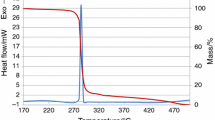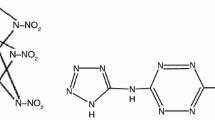Abstract
Thermal decomposition behavior and kinetics of aluminized polymer-bonded explosives (PBXs) based on l,3,5,7-tetranitro-1,3,5,7-tetrazocane (HMX) bonded by hydroxyl-terminated polybutadiene (HTPB) and aluminum powder were investigated. Different from the literature, aluminized PBXs have undergone three-steps decomposition measured by thermogravimetry which could be best distinguished by derivative thermogravimetric study. Results revealed that the thermal decomposition behavior has been significantly influenced in the presence of Al and HTPB matrix, especially reducing the thermal stability than that of neat HMX. The reactivity of aluminized PBXs has been rationalized on the basis of dependence of the effective activation energy upon conversion determined via the popular isoconversional methods and compared with peak temperature at maximum reaction rate method. Resulting activation energy dependence obtained for the first stage has been found to be 82.2–231.3 kJ mol−1 in the region of 0.05–0.25 for the slow pyrolysis, followed by a significant variation in the anomalous activation energy with conversion from 446.9 to 1282.8 kJ mol−1 in the region of 0.3–0.6 for the second-stage decomposition of aluminized PBXs. The above-mentioned values are in good agreement with those obtained from the Kissinger method. Thermodynamic parameters for the formation of the activated complex, and critical temperature and self-accelerating for thermal explosion were also determined.










Similar content being viewed by others
References
Yu Y, Chen S, Li T, Jin S, Zhang G, Chenb M, Li L. Study on a novel high energetic and insensitive munitions formulation: TKX-50 based melt cast high explosive. RSC Adv. 2017;31(7):485–92.
Agrawal JP. High energy materials: propellants, explosives and pyrotechnics. Hoboken: Wiley; 2010.
Talawar M, Sivabalan R, Mukundan T, Muthurajan H, Sikder AK, Gandhe BR, Rao AS. Environmentally compatible next generation green energetic materials (GEMs). J Hazard Mater. 2009;162:589–607.
Badgujar D, Talawar M, Asthana S, Mahulikar P. Advances in science and technology of modern energetic materials: an overview. J Hazard Mater. 2008;151:289–305.
An C, Li F, Song X, Wang Y, Guo X. Surface coating of RDX with a composite of TNT and an energetic-polymer and its safety investigation. Propell Explos Pyrotech. 2009;34:400–5.
Mishra VS, Bhagat AL, Vadali SR, Singh VK, Wasnik RD, Asthana S. Effect of tungsten on aluminized melt cast high explosive formulations. Cent Eur J Energ Mater. 2012;9:147–54.
Carney JR, Miller JS, Gump JC, Pangilinan GI. Time-resolved optical measurements of the post-detonation combustion of aluminized explosives. Rev Sci Instrum. 2006;77:63–103.
Arkhipov VI, Makhov MN, Pepekin VI, Shchetinin VG. Investigations into detonation of aluminized high explosives. Chem Phys Rep. 2000;18:2329–37.
Vadhe PP, Pawar RB, Sinha RK, Asthana SN, Rao AS. Cast aluminized explosives. Combust Explos Shock Waves. 2008;44:461–77.
Muravyev N, Frolov Y, Pivkina A, Monogarov K, Ordzhonikidze O, Bushmarinov I, Korlyukov A. Influence of particle size and mixing technology on combustion of HMX/Al compositions. Propell Explos Pyrotech. 2010;35:226–32.
Manner VW, Pemberton SJ, Gunderson JA, Herrera TJ, Lloyd JM, Salazar PJ, Rae P, Tappan BC. The Role of aluminum in the detonation and post-detonation expansion of selected cast HMX-based explosives. Propell Explos Pyrotech. 2012;37:198–206.
Gogulya MF, Makhov MN, Dolgoborodov AY, Brazhnikov MA, Arkhipov VI, Shchetinin VG. Mechanical sensitivity and detonation parameters of aluminized explosives. Combust Explos Shock Waves. 2004;40:445–57.
Lucio B, Fuente J, Luis DL. Kinetic and thermodynamic analysis of the polymerization of polyurethanes by a rheological method. Thermochim Acta. 2016;625:28–35.
Krabbendam-LaHaye ELM, De Klerk WPC, Kramer RE. The kinetic behaviour and thermal stability of commercially available explosives. J Therm Anal Calorim. 2005;80:495–501.
Bunyan P, Baker C, Turner N. Application of heat conduction calorimetry to high explosives. Thermochim Acta. 2003;401:9–16.
Keshavarz MH, Moradi S, Ebrahimi B, Rahimi H, Madram A. A simple accurate model for prediction of deflagration temperature of energetic compounds. J Therm Anal Calorim. 2013;112:1453–63.
Zou HM, Chen SS, Li X, Jin SH, Niu H, Wang F, Chao H, Fang T, Shu QH. Preparation, thermal investigation and detonation properties of ε-CL-20-based polymer-bonded explosives with high energy and reduced sensitivity. Mater Exp. 2017;7:199–208.
Sikder AK. Studies on energetic compounds. J Therm Anal Calorim. 2005;79:631–5.
Yan QL, Zeman S, Elbeih A. Recent advances in thermal analysis and stability evaluation of insensitive plastic bonded explosives (PBXs). Thermochim Acta. 2012;537:1–12.
Yan QL, Zeman S, Selesovsky J, Svoboda R, Elbeih A. Thermal behaviour and decomposition kinetics of Formex-bonded explosives containing different cyclic nitramines. J Therm Anal Calorim. 2013;111:1419–30.
Yan QL, Zeman S, Svoboda R, Elbeih A. Thermodynamic properties, decomposition kinetics and reaction models of BCHMX and its Formex bonded explosive. Thermochim Acta. 2012;547:150–60.
Yan QL, Zeman S, Zhao F, Elbeih A. Non-isothermal analysis of C4 bonded explosives containing different cyclic nitramines. Thermochim Acta. 2013;556:6–12.
Yan QL, Zeman Z, Elbeih A. Thermal behaviour and decomposition kinetics of Viton A bonded explosives containing attractive cyclic nitramines. Thermochim Acta. 2013;562:56–64.
Yan QL, Zeman Z, Zang T, Elbeih A. Non-isothermal decomposition behaviour of fluorel bonded explosives containing attractive cyclic nitramines. Thermochim Acta. 2013;574:10–8.
Yan QL, Zeman Z, Elbeih A, Zbynek A. The influence of the semtex matrix on the thermal behaviour and decomposition kinetics of cyclic nitramines. Cent Eur J Energ Mater. 2013;10:509–58.
Zeman Z, Elbeih A, Yan QL. Note on the use of the vacuum stability test in the study of initiation reactivity of attractive cyclic nitramines in Formex. J Therm Anal Calorim. 2013;111:1503–6.
Zeman S, Elbeih A, Yan QL. Notes on the use of the vacuum stability test in the study of initiation reactivity of attractive cyclic nitramines in the C4 matrix. J Therm Anal Calorim. 2013;112:1433–7.
Kader AM, Bhwmick AK. Thermal ageing, degradation and swelling of acrylic rubber, fluororubber and their blends containing polyfunctionalacrylates. Polym Degrad Stab. 2003;79:283–95.
Shuping Z, Yulong W, Mingde Y, Chun L, Jummao T. Pyrolysis characteristics and kinetics of the marine microalgae Dunaliellatertiolecta using thermogravimetric analyzer. Bioresour Technol. 2010;101:359–65.
Criado JM, Malek J, Ortega A. Applicability of the master plots in kinetic analysis of non-isothermal data. Thermochim Acta. 1989;147:377–85.
Nunez L, Fraga F, Nunez MR, Villanueva M. Thermogravimetric study of the decomposition process of the system BADGE (n = 0)/1,2 DCH. Polym. 2000;41:4635–41.
Poletto M, Dettenborn J, Pistor V, Zeni M, Zattera AJ. Materials produced from plant biomass. Part I: evaluation of thermal stability and pyrolysis of wood. Mater Res. 2010;13:375–9.
Sanchez-Jimenez PE, Perez-Maqueda LA, Perejon A, Criado JM. A new model for the kinetic analysis of thermal degradation of polymers driven by random scission. Polym Degrad Stab. 2010;95:733–9.
Sanchez-Silva L, Lopez-Gonzalez D, Villasenor J, Sánchez P, Valverde JL. Thermogravimetric-mass spectrometric analysis of lignocellulosic and marine biomass pyrolysis. Bioresour Technol. 2012;109:163–72.
Tiptipakorn S, Damrongsakku LS, Ando S, Hemvichian K, Rimdusit S. Thermal degradation behaviours of polybenzoxazine and silicon-containing polyimide blends. Polym Degrad Stab. 2007;92:1265–78.
Maulding HV, Zoglio MA. Flexible non-isothermal stability studies. J Pharm Sci. 1970;59:333–7.
Flynn JH, Wall LA. General treatment of the thermogravimetry of polymers. J Res Natl Bur Stand A Phys Chem. 1966;70:487–523.
Ozawa T. A new method of analyzing thermogravimetric data. Bull Chem Soc Jpn. 1965;38:1881–6.
Zoglio MA, Windheuser JJ, Maulding HV Jr, Kornblum SS, Jacobs AL, Hamot H. Linear nonisothermal stability studies. J Pharm Sci. 1968;57:2080–5.
Doyle CD. Estimating isothermal life from thermogravimetric data. J Appl Polym Sci. 1962;6:639–42.
Doyle CD. Kinetic analysis of thermogravimetric data. J Appl Polym Sci. 1961;5:285–92.
Vyaovkin S. Computational aspects of kinetics project-the light at the end of tunnel? Thermochim Acta. 2000;355:155–63.
Pistor V, Ornaghi FG, Ornaghi HL, Fiorio JR, Zattera AJ. Thermal characterization of oil extracted from ethylene-propylene-dienetermopolymer residues (EPDM-r). Thermochim Acts. 2010;510:93–6.
Vyazovkin S, Wight CA. Model-free and model-fitting approaches to kinetic analysis of isothermal and nonisothermal data. Thermochim Acta. 1999;340:53–68.
Sbirrazzuoli N, Vyazovkin S. Learning about epoxy cure mechanisms from isoconversional analysis of DSC data. Thermochim Acta. 2002;388:289–98.
Vyazovkin SV, Goryachko VI, Lesnikovich AI. An approach to the solution of the inverse kinetic problem in the case of complex processes. Part III. Parallel independent reactions. ThermochimActa. 1992;197:41–51.
Vyazovkin S. Conversion dependence of activation energy for model DSC curves of consecutive reactions. Thermochim Acta. 1994;236:1–13.
Poletto M, Zattera AJ, Santana MC. Thermal decomposition of wood: kinetics and degradation mechanisms. Bioresour Technol. 2012;126:7–12.
Akahira T, Sunose T. Res Report CHIBA Inst Technol. 1971;16:22.
Kissinger HE. Reaction kinetics in differential thermal analysis. Anal Chem. 1957;29:1702–6.
Friedman H. Kinetics of thermal degradation of char-forming plastics from thermogravimetry. Application to a phenolic plastic. J Polym Sci C. 1964;6:183–95.
Lee JS, Hsu CK, Chang CL. A study on the thermal decomposition behaviors of PETN, RDX, HNS and HMX. Thermochim Acta. 2002;392:173–6.
Carty P, Metcalfe E, Saben TJ. Thermal analysis of plasticised PVC containing flame retardant/smoke suppressant inorganic and organometallic iron compounds. Fir Saf J. 1991;17:45–56.
Elbeih A, Abd-Elghany M, Klapçtke TM. Kinetic Parameters of PBX Based on Cis-1,3,4,6-tetranitroocta-hydroimidazo-[4,5-d] imidazole obtained by isoconversional methods using different thermal analysis techniques. Propell Explos Pyrotech. 2017;42:1–10.
Singh G, Felix SP, Pandey DK, Agrawal JP, Sikder AK. Studies on energetic compounds Part XXXIX. Thermal analysis of a plastic bonded explosive containing RDX and HTPB. J Therm Anal Calorim. 2005;79:631–5.
Singh A, Sharma TC, Kishore P. Thermal degradation kinetics and reaction models of 1,3,5-triamino-2,4,6-trinitrobenzene-based plastic-bonded explosives containing fluoropolymer matrices. J Therm Anal Calorim. 2017;129:1403–14.
Singh A, Sharma TC, Narang JK, Kishore P, Srivastava A. Thermal decomposition and kinetics of plastic bonded explosives based on mixture of HMX and TATB with polymer matrices. Def Technol. 2017;13:22–32.
Abd-Elghany M, Elbeih A, Hassanein S. Thermal behavior and decomposition kinetics of RDX and RDX/HTPB composition using various techniques and methods. Cent Eur J Energ Mater. 2016;13:714–35.
Pinheiro GFM, Lourenço VL, Iha K. Influence of the heating rate in the thermal decomposition of HMX. J Ther Anal Calorim. 2002;67:445–52.
Elbeih A, Abd-Elghany M, Elshenawy T. Application of vacuum stability test to determine thermal decomposition kinetics of nitramines bonded by polyurethane matrix. Acta Astronaut. 2016;132:124–30.
Zhang P, Guo XY, Zhang JY, Jiao QJ. Application of liquid paraffin in castable CL-20-based PBX. J Energ Mater. 2014;32:278–92.
Abusaidi H, Ghaieni HR. Thermal analysis and kinetic decomposition of Nitro-functionalized hydroxyl-terminated polybutadiene bonded explosive. J Therm Anal Calorim. 2017;127:2301–6.
Abusaidi H, Ghaieni HR, Pourmortazavi SM, Motamed-Shariati SH. Effect of nitro content on thermal stability and decomposition kinetics of Nitro-HTPB. J Therm Anal Calorim. 2016;124:935–41.
Wang H. Thermal decomposition of HTPB/AP and HTPB/HMX mixtures with low content of oxidizer. J Therm Anal Calorim. 2014;19:1673–8.
Sinha YK, Sridhar BTN, Kishnakumar R. Study of thermo-mechanical properties of HTPB–paraffin solid fuel. J Sci Eng. 2016;41:4683–90.
Singh A, Singh S, Sharma TC, Srivastava A. Physicochemical properties and kinetic analysis for some fluoropolymers by differential scanning calorimetry. Polym Bull. 2018;75:2315–38.
Xu WB, Bao SP, Shen SJ, Wang W, Hang GP, He PS. Differential scanning calorimetric study on the curing behavior of epoxy resin/diethylenetriamine/organic montmorillonite nanocomposite. J Polym Sci B Polym Phys. 2003;41:378–86.
Iglesias M, Eyler N, Canizo A. Kinetics of the thermal decomposition reaction of diethylketone cyclic triperoxide in acetone-toluene and acetone-1-propanol binary solvent mixtures. J Phys Org Chem. 2009;22:96–100.
Guo S, He J, Luo W, Liu F. Research on the thermal decomposition reaction kinetics and mechanism of pyridinol-blocked isophorone diisocyanate. Materials. 2016;9:110. https://doi.org/10.3390/ma9020110.
Tsyshevsky RV, Sharia O, Kuklja MM. Molecular theory of detonation initiation: insight from first principles modelling of the decomposition mechanisms of organic nitro energetic materials. Molecules. 2016;21:236.
Zhang RI, Hu TL, Xie RZ, Li FP. The estimation of critical temperatures of thermal explosion for energetic materials using non-isothermal DSC. Thermochim Acta. 1994;244:171–6.
Sovizi MR, Hajimirsadeghi SS, Naderizadeh B. Effect of particle size on thermal decomposition of nitrocellulose. J Hazard Mater. 2009;168:1134–9.
Acknowledgements
The authors express their thanks to Dr. Manjit Singh, Distinguished Scientist/Director, for his constant motivation, guidance and fruitful discussion. The authors are also thankful to TC Sharma and Mahesh Kumar for their kind support for providing thermal analytical facilities and recording some TG measurements.
Author information
Authors and Affiliations
Corresponding author
Rights and permissions
About this article
Cite this article
Singh, A., Soni, P.K., Sarkar, C. et al. Thermal reactivity of aluminized polymer-bonded explosives based on non-isothermal thermogravimetry and calorimetry measurements. J Therm Anal Calorim 136, 1021–1035 (2019). https://doi.org/10.1007/s10973-018-7730-9
Received:
Accepted:
Published:
Issue Date:
DOI: https://doi.org/10.1007/s10973-018-7730-9




